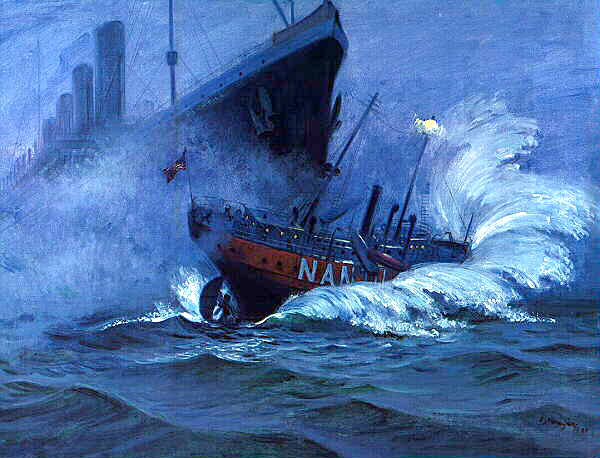
United States Coast Guard - 200th Anniversary
One of the most monotonous, arduous and dangerous duties that the Coast Guard and one of its predecessors, the U.S. Lighthouse Service1 performed was manning lightships. The Nantucket station established in 1854, had become the major beacon that guided vessels from Europe to New York and other Atlantic coast ports.
Nantucket was built in 1930 and was first placed on station in May 1931. The ship carried the most modern signaling equipment of the day. It was 133-feet ~ng overall and thirty feet in the beam, displacing 630 tons. Anchored forty-one miles from the nearest land, the lightship guided ocean traffic with a radiobeacon signal system and lights. Ships could take radio bearings on Nantucket from as far away as 300 miles. Duty at the station was hazardous because many of the large steamers, using the beacon as a navigating aid, steered directly towards the lightship. This danger was compounded by the frequent and heavy fogs in the area. The radio beacon system worked so accurately that in January 1934 the ocean liner Washington, which had steered directly toward the signal sideswiped Nantucket. The Washington sheared off the lightship~s boat davits, a lifeboat, and antennas. The Lighthouse Service quickly repaired Na~tucket and placed it back on station. A few months later it was struck again. Just after 10 a.m. on the morning of May 12, 1934, the passenger liner Olympic, sister ship of the Titanic, collided with and sank Nantucket. Olympic, nearly seventy-five times larger than the lightship and travelling at about twenty knots, struck it broadside in heavy fog and drove it to the bottom. Boats from Olympic were imm~ diately put over, but the lightship sank within minutes. Seven of the eleven lightship crewmen were killed.
The Coast Guard assumed responsibility for all lighthouses and lightships in 1939 when the Lighthouse Service joined the agency. The Coast Guard continued this service until 1985 when the last lightship, the Nantucket, was replaced by a large navigation buoy. This ended the era of lightships as navigational aids which lasted for over 150 years.
Artist: Charles Mazoujian
